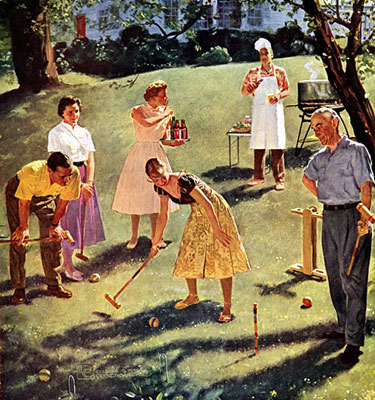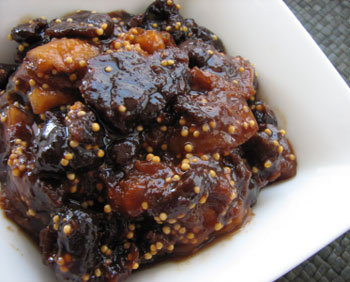 I spent a year living in Europe, and six months of that was in Italy. Having eaten a lot of Italian food, I like to think I understand it, perhaps just a little. In fact, whenever I try to recreate an Italian dish I think back to earlier versions that I've eaten. What was it that I liked about it? What was the essence of the dish?
I spent a year living in Europe, and six months of that was in Italy. Having eaten a lot of Italian food, I like to think I understand it, perhaps just a little. In fact, whenever I try to recreate an Italian dish I think back to earlier versions that I've eaten. What was it that I liked about it? What was the essence of the dish?
In all my time in Italy, I don't remember trying mostarda. It's not surprising really because the most well-known versions come from Veneto, Lombardia and Piemonte. Most of my time was spent in Tuscany. But I still think I understand mostarda, just a bit. It's like an Italian chutney I suppose. Don't make the mistake of translating it as "mustard". Mostarda does have a little bit of mustard in it, but it's really a combination of preserved fruit in syrup with a bit of a kick. The kick comes from mustard oil, mustard essence, dry mustard, mustard seeds or some combination thereof. Other ingredients include sugar or honey, wine, vinegar and sometimes citrus juice.
When I am developing a recipe, I often look for several variations then strike off on my own. The recipes I found for mostarda varied greatly--some used dry fruit, others fresh fruit. Some cooked slowly others cooked quickly. Some had lots of mustard, others barely a pinch. My own experiment lead me to this conclusion: Mostarda is very forgiving and can easily be made to your own taste. You can taste as you go and make changes.
Retro Recipes and Traditional Fare
Retro Recipes and Traditional Fare
Peach Galette
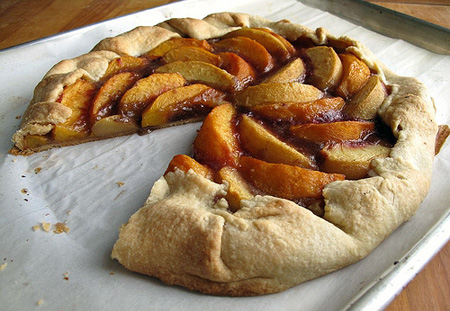 I can never tire of a rustic dessert, especially one made with fresh, perfectly ripe peaches. Fruits like these when at their peak always make the difference, turning a ho-hum dessert into a spectacular one. I'd like to think that peach desserts are an American specialty, particularly a Southern one. There is the traditional peach cobbler, peach crisp, and peach crumble. There are also the peach pie and tart. But when simply baked on a pan with the edges of the dough turned over, you have what the French call a galette and the Italians a crostata. An extra crispy crust sets the galette or crostata apart from pies and tarts.
I can never tire of a rustic dessert, especially one made with fresh, perfectly ripe peaches. Fruits like these when at their peak always make the difference, turning a ho-hum dessert into a spectacular one. I'd like to think that peach desserts are an American specialty, particularly a Southern one. There is the traditional peach cobbler, peach crisp, and peach crumble. There are also the peach pie and tart. But when simply baked on a pan with the edges of the dough turned over, you have what the French call a galette and the Italians a crostata. An extra crispy crust sets the galette or crostata apart from pies and tarts.
This crispiness is achieved by baking at high temperature and can not only be attained by professional bakers, but by home bakers too. Preheat the oven with a pizza stone and after adequately heating for a half hour, bake the galette in a pan placed over the stone. This is the foolproof method for the crispiest crust, but what if it's sill soggy? The French secret to keeping the crust from getting soggy is a thin layer of ground nuts between the dough and fruit. The Italians use amaretti crumbs. The nuts or crumbs absorb the excess liquid from the fruit and create a thickened consistency. They almost go unnoticed in the finished dessert.
Santa Maria-Style Barbecue
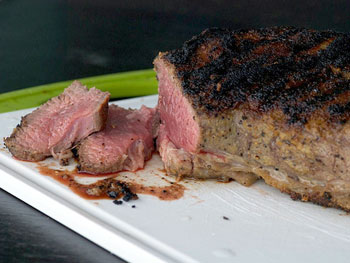 Barbecue. You know what it means, right? Are you sure? Having grown up in Rhode Island I always thought a "barbecue" referred to an outdoor cookout featuring grilled hot dogs and hamburgers. It wasn't until we moved to North Carolina that we discovered "barbecue" had nothing to do with hot dogs and hamburgers and everything to do with slowly cooking a whole hog over some flames.
Barbecue. You know what it means, right? Are you sure? Having grown up in Rhode Island I always thought a "barbecue" referred to an outdoor cookout featuring grilled hot dogs and hamburgers. It wasn't until we moved to North Carolina that we discovered "barbecue" had nothing to do with hot dogs and hamburgers and everything to do with slowly cooking a whole hog over some flames.
Now that we live in Southern California, I've fallen for Santa Maria-style barbecue made from tri-tip, a flavorful, triangular cut of beef from the bottom sirloin.
Santa Maria-style barbecue originated in the Santa Maria Valley in Central California in the 19th century. After cattle round-ups, American cowboys, known as vaqueros, would host huge gatherings that featured beef skewered and cooked over a red oak fire. The beef was simply seasoned with salt and pepper and served with Pinquito beans, salsa, bread, and simple desserts. It hasn't changed much in almost two centuries.
Beurre Blanc
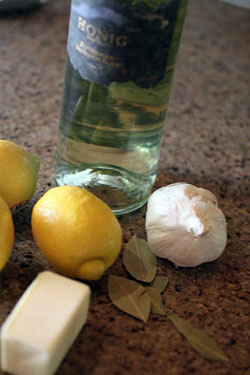 Butter and white wine…already you know this is good! Literally the French term for “white butter,” a buerre blanc is a traditional sauce with simple ingredients. Quite elegant and versatile for many dishes and full of garden flavors, this beurre blanc can become a backbone for your garden living lifestyle.
Butter and white wine…already you know this is good! Literally the French term for “white butter,” a buerre blanc is a traditional sauce with simple ingredients. Quite elegant and versatile for many dishes and full of garden flavors, this beurre blanc can become a backbone for your garden living lifestyle.
Brown an onion in some olive oil. Salt and pepper for flavor and then add garlic once the onion begins to caramelize. This is the background and foundation of your sauce, for the caramelized bits of onion and garlic are the keepers of amazing flavor. The wine will deglaze the pan, releasing the browned goodness of the onion cousins. Allow the wine to come to a simmer and reduce by a third. This step, reducing the wine, intensifies the flavor of the wine, concentrating the bouquet and natural essence of the wine. Tossing in a couple bay leaves awakens the sauce and steeps their flavor in the wine reduction.
Now for the namesake - butter. Add the cubed butter in shifts, whisking the butter into the sauce and allowing it to thoroughly melt it. Once the butter has thoroughly melted into the wine, the smooth sauce can now be livened up even more with some fresh lemon juice and zest.
Poires Belle Helene
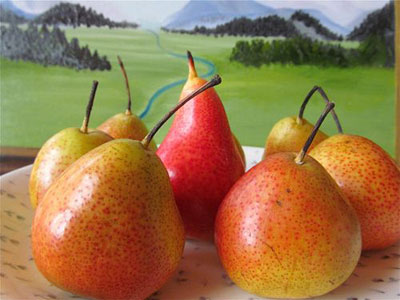 These tiny, almost impossibly perfect little Forelle pears are the kind I could only imagine in an Hironymous Bosch painting. They weigh almost nothing and go down in two bites.
These tiny, almost impossibly perfect little Forelle pears are the kind I could only imagine in an Hironymous Bosch painting. They weigh almost nothing and go down in two bites.
I had never seen them before, and when I looked them up I discovered they are an old variety dating back to the 1600s in Germany. I spotted them in a supermarket and asked the staff what their name was. “I don’t know, but no one is buying them.”
I scooped up a few and coveted their shiny colorful beauty in such a small package. I placed them on a plate and put them in front of one of my recent paintings. I gazed at them for almost a week before deciding to use them to make a French classic dessert: Poires Belle Helene—a chocolate dessert with a healthy twist to it.
As far as easy desserts go, this has to be one of the easiest. Poach the pears. Ladle warm chocolate sauce over them. And use any kind of pear. I just happened to fall in love with these little wonders!
More Articles ...
Welcome to the new One for the Table ...
Our Home Page will be different each time you arrive.
We're sure you'll find something to pique your interest...

